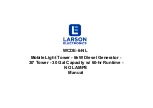
1 UNBALANCED
•
Use a twin RCA-to-RCA lead to connect these sockets to the left and
right analog input of a receiver or amplifier.
2 BALANCED
•
Connect these XLR connectors to the corresponding XLR input of
professional audio amplifiers.
•
Ensure that proper pin configurations are followed – Pin 1: Ground,
Pin 2: Positive (signal live) and Pin 3: Negative (signal return).
3 AES/EBU
•
Digital audio stream from professional audio sources like SACD/CD
Players or processors can be connected to this XLR connector.
•
For high-end sources with higher sampling rates like 176kHz and
192kHz, it is highly recommended that such sources be interfaced
with the AES/EBU IN connector. The AES/EBU IN is well suited to
handle such sources with high sampling rate.
4 COAXIAL, OPTICAL
•
Connect COAXIAL and/or OPTICAL to corresponding S/PDIF output
of sources such as CD, DVD or BD players, digital cable box, digital
tuners and other applicable components.
5 USB
•
Using Type A to Type B cable connector (not supplied), interface
computer audio to this asynchronous Type B USB input to directly
stream 24/192 content from your PC, MAC or NAS (network-
attached storage).
•
In order to stream your computer audio via C 510, the “NAD USB
Audio driver” that can be downloaded from the NAD website must
be installed.
•
Most PCs or MACs can automatically detect C 510, with “NAD USB
Audio” already available as one of the playback device options in
their respective audio device management settings. Select “NAD
USB Audio” as the playback sound or audio setting on your PC or
Mac.
•
For more information, refer to the NAD USB AUDIO item in the
USING THE C 510 – OTHER FEATURES.
IMPORTANT NOTICE
The use of the NAD USB Audio driver downloaded through the NAD site
is done at the customer’s own discretion and risk. The customer will be
solely responsible for any damage to his/her computer system or loss of
data arising out of or in connection with the use of this software driver.
In no event shall NAD be liable for any direct, indirect, incidental, special,
exemplary, or consequential damages including negligence or otherwise
arising in any way out of the use of this software driver.
6 HDMI (HDMI 1,2; HDMI VIDEO OUT)
•
Connect HDMI 1-2 inputs to the HDMI OUT connectors of source
components such as BD/DVD player or HDTV satellite/cable box.
•
Connect the HDMI VIDEO OUT to a HDTV or projector with HDMI
input.
NOTE
HDMI 1-2 and HDMI VIDEO OUT function only as direct pass through.
WARNING
Before connecting and disconnecting any HDMI cables, both the C 510
and the ancillary source must be powered OFF and unplugged from the
AC outlet. Failure to observe this practice may cause permanent damage
to all equipment connected via HDMI sockets.
7 UPGRADE
•
C 510 may need a software update to be in step with the latest
technology trends. Check with your authorized NAD distributors for
future software updates. Only authorized NAD distributors or service
centers are allowed to implement a software update.
•
Connect to this input a USB memory stick containing the software
update. Use USB adaptor when necessary.
8 +12V TRIGGER OUT
•
The +12V TRIGGER OUT is used for controlling external equipment
that is equipped with a +12V trigger input. This output will be 12V
when the C 510 is ON and 0V when the unit is either OFF or in
standby.
IDENTIFICATION OF CONTROLS
REAR PANEL
ATTENTION!
Please make sure that the C 510 is powered off or unplugged from the mains power source before making any connections. It is also advisable to power
down or unplug all associated components while making or breaking any signal or AC power connections.
© NAD C510
+12V TRIGGER OUT
4
5
6
7
8
9
10 11
13 14
1
2
3
12
7
ENGLISH
FR
ANÇ
AIS
ESP
AÑOL
IT
ALIANO
DEUT
SCH
NEDERL
ANDS
SVENSK
A
РУ
ССКИЙ


































